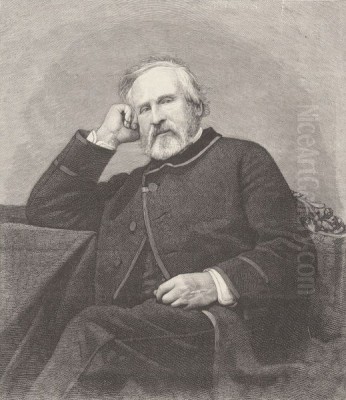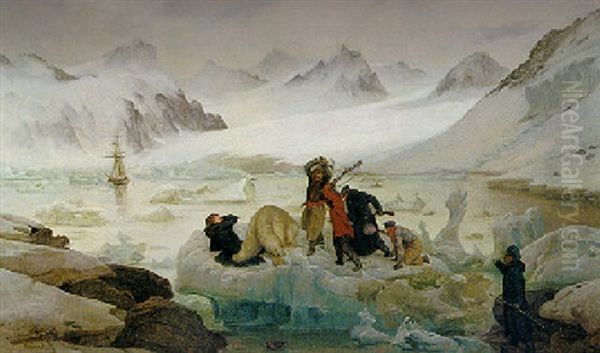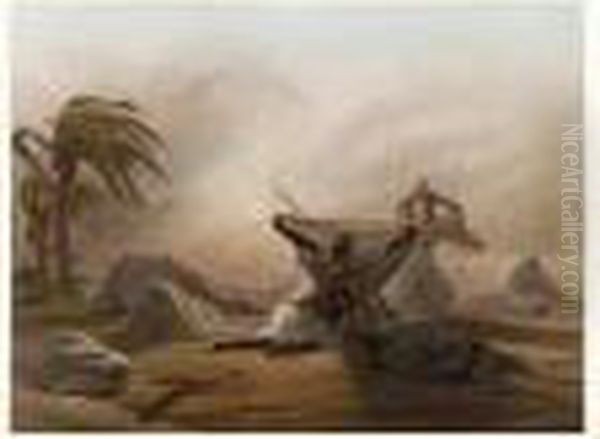
François-Auguste Biard (1799–1882) stands as a distinctive figure in the landscape of 19th-century French art. A painter whose life was as colorful and varied as his canvases, Biard was an intrepid traveler, a keen observer of humanity, and an artist who defied easy categorization. His extensive journeys to the Arctic, Brazil, Africa, and beyond provided him with a rich tapestry of subjects, from breathtaking natural wonders and ethnographic studies to incisive social commentary and scenes brimming with humor. While sometimes overlooked in grand narratives of art history, Biard's unique contributions, his adventurous spirit, and his diverse body of work merit closer examination, revealing an artist who captured the expanding worldview and complex realities of his era.
Early Life and Artistic Awakenings in Lyon
Born in Lyon, France, on June 27, 1799 (though some sources cite 1798), François-Auguste Biard's path to an artistic career was not straightforward. His mother, adhering to traditional aspirations, initially envisioned a future for him within the clergy. This early push towards a religious life, however, could not suppress the young Biard's burgeoning passion for the visual arts. He ultimately veered away from theological studies, choosing instead to pursue his artistic inclinations.
Biard was largely self-taught in his formative years, a testament to his innate talent and determination. He honed his skills through diligent practice and observation. Later, he sought more formal instruction, attending the École des Beaux-Arts in Lyon. This period of study would have provided him with a foundational understanding of academic principles, drawing, and composition, even as his independent spirit and unique vision began to take shape. Lyon, a significant cultural and industrial hub, would have offered a stimulating environment, though Paris, the undisputed center of the French art world, would soon beckon. His early experiences, including the resistance to a pre-ordained career path, perhaps sowed the seeds for the independent and often unconventional approach he would later bring to his art and life.
Parisian Debut and Salon Recognition

The allure of Paris was irresistible for any ambitious French artist, and Biard was no exception. He made his way to the capital, eager to immerse himself in its vibrant artistic milieu and to seek recognition at the prestigious Paris Salon. The Salon, organized by the Académie des Beaux-Arts, was the official, state-sponsored exhibition and the primary venue for artists to display their work, gain critical attention, and secure patronage. Success at the Salon could make or break an artist's career.
Biard began exhibiting at the Salon in the 1820s, and his works quickly garnered attention. His paintings, often characterized by their lively subjects, narrative clarity, and sometimes a touch of the dramatic or humorous, stood out. He achieved notable success, winning a second-class medal at the Salon of 1827. This was a significant early validation of his talent. His reputation continued to grow, culminating in a first-class medal at the Salon of 1836. These accolades cemented his status as a recognized painter in the competitive Parisian art scene. King Louis-Philippe I himself became an admirer and patron, acquiring several of Biard's works for the royal collections, a clear indicator of his rising prominence.
During this period, Biard's subject matter was diverse, encompassing genre scenes, historical subjects, and landscapes. He demonstrated a particular aptitude for capturing human interaction and imbuing his scenes with a sense of immediacy. His contemporaries at the Salon included giants of French art like Eugène Delacroix, whose Romantic fervor and exotic subjects were transforming the artistic landscape, and Jean-Auguste-Dominique Ingres, the staunch defender of Neoclassical tradition. Biard navigated this dynamic environment, carving out his own niche.
The Grand Tour and Mediterranean Explorations
Like many artists of his generation, Biard undertook travels that were considered essential for artistic and cultural education. He journeyed through Italy, Greece, and the Middle East, regions steeped in classical antiquity and rich artistic heritage. These travels, part of the tradition of the Grand Tour, exposed him to the masterpieces of the Renaissance, the ruins of ancient civilizations, and the diverse cultures of the Mediterranean basin.

These experiences undoubtedly broadened his artistic horizons and provided him with new subjects and inspirations. While he may not have focused on classical ruins with the same intensity as some of his Neoclassical contemporaries, the vibrant street life, picturesque landscapes, and distinct cultural practices he encountered would have informed his developing interest in depicting diverse human experiences. His paintings from this period likely reflected an engagement with local color and customs, a precursor to the more extensive ethnographic interests that would define his later career. The influence of Orientalist painters like Alexandre-Gabriel Decamps or Prosper Marilhat, who were also exploring North Africa and the Middle East, might have resonated with Biard's own burgeoning interest in exotic locales.
The Call of the North: Arctic Expeditions
One of the most defining aspects of Biard's career was his participation in scientific and artistic expeditions to the far North. In 1838-1839, he joined the French La Recherche expedition, which journeyed to Spitsbergen (Svalbard) and Lapland. This was a remarkable undertaking for an artist at the time, venturing into harsh, remote, and largely uncharted territories. The expedition, led by Joseph Paul Gaimard, had scientific objectives, including the study of geology, meteorology, and marine life, but it also recognized the value of artistic documentation.
Biard, along with fellow artists such as Charles Giraud and Barthélemy Lauvergne, was tasked with visually recording the landscapes, atmospheric phenomena, and the lives of the indigenous Sámi people. His experiences in the Arctic had a profound impact on his art. He produced a series of striking paintings depicting the dramatic ice-bound landscapes, the ethereal beauty of the aurora borealis, and the challenges of life in the polar regions. Works like Magdalena Bay, View of the Ice Surrounding the Corvette La Recherche (1841) capture the sublime and often perilous nature of the Arctic environment. He also painted scenes of encounters with polar bears, such as Fight with Polar Bears, showcasing the dramatic potential of these northern adventures.
These Arctic paintings were significant not only for their artistic merit but also for their contribution to the European public's understanding of these remote regions. In an era before photography became widespread, Biard's canvases offered vivid glimpses into a world few had ever seen. His depictions of the Sámi people also contributed to the growing ethnographic interest in non-European cultures, a theme that would continue in his subsequent travels. His work in the Arctic can be seen in the context of other artists who documented exploration, such as Karl Bodmer who accompanied Prince Maximilian of Wied-Neuwied to North America.
Brazilian Adventures and "Deux ans au Brésil"

Following his Arctic explorations, Biard's adventurous spirit led him to an entirely different clime: the tropical landscapes of Brazil. He spent approximately two years in Brazil, from 1858 to 1859, a period that proved immensely fruitful for his art. He traveled extensively within the country, including expeditions into the Amazon rainforest, where he encountered indigenous communities and documented the lush, exotic flora and fauna.
His Brazilian experiences resulted in a significant body of work, including vibrant landscapes, detailed studies of indigenous peoples, and scenes of colonial life. He was fascinated by the diversity of Brazilian society, from the urban centers to the remote jungle settlements. His paintings often captured the unique customs, attire, and daily activities of the people he met.
Upon his return to France, Biard published an illustrated account of his travels, Deux ans au Brésil (Two Years in Brazil), in 1862. The book, featuring numerous wood engravings based on his sketches and paintings, provided a vivid narrative of his adventures and observations. It was a popular success, further enhancing his reputation as an artist-explorer. Works like Indians of Brazil or scenes depicting life on Amazonian rivers showcased his ability to convey the richness and complexity of this South American nation. His ethnographic interest aligns with a broader 19th-century fascination with the "exotic," though Biard's depictions often carried a more personal and observational quality than some of the more romanticized or stereotyped images produced by other Orientalist or exoticist painters.
African Sojourns and the Shadow of the Slave Trade
Biard's travels also took him to the coasts of Africa. While the exact dates and extent of these journeys are sometimes less precisely documented than his Arctic or Brazilian expeditions, his experiences on the African continent inspired some of his most powerful and socially conscious works. He witnessed firsthand the devastating impact of the transatlantic slave trade, a practice that, while officially abolished by many European nations by this time, continued illicitly and left deep scars.
His most famous painting on this subject, The Slave Trade (Slaves on the Coast of Africa), exhibited at the Salon of 1835 (though some sources suggest earlier dates for similar works), is a harrowing depiction of the brutal reality of human trafficking. The painting shows enslaved Africans being inspected by European traders on a beach, a scene filled with despair, cruelty, and the dehumanizing aspects of the trade. This work was highly impactful and controversial, contributing to the abolitionist discourse of the time. It stands as a significant example of an artist using their platform to address a pressing social and moral issue.
Other works, such as Scenes on the Coast of Africa, further explored African landscapes and encounters, though often with a focus on the dramatic or the picturesque. Biard's engagement with the theme of slavery places him in the company of other artists who tackled difficult social realities, such as Théodore Géricault with his Raft of the Medusa, which, while not directly about slavery, addressed human suffering and official negligence. Biard's direct confrontation with the slave trade in his art was particularly bold for its time.
Genre Scenes, Humor, and Social Satire
Beyond his grand travelogues, Biard possessed a keen eye for the everyday and a distinct sense of humor, which often manifested in his genre paintings. He delighted in depicting scenes of ordinary life, often infused with a comical or satirical edge. These works frequently portrayed the foibles of human nature, the absurdities of social conventions, and the charming quirks of provincial or working-class life.
His subjects included bustling marketplaces, theatrical performances, bumbling officials, and rustic festivities. He had a talent for capturing expressive gestures and creating lively, anecdotal compositions. Paintings like The Fortune Teller or scenes of village doctors attending to bewildered patients showcase this lighter, more humorous side of his oeuvre. His satirical wit is perhaps best exemplified in The Salon of 1847, or Four O'Clock at the Salon, a painting that humorously critiques the behavior of the Parisian art public, showing them more interested in socializing and being seen than in appreciating the art on display. This work offers a witty commentary on the art world itself, a subject few artists dared to tackle with such directness.
This aspect of Biard's work can be compared to the genre traditions of Dutch Golden Age painters like Jan Steen, who also excelled at depicting lively, humorous scenes of everyday life. In the French context, his humorous genre scenes offered a contrast to the more serious academic history paintings or the idealized landscapes favored by some of his contemporaries.
Orientalist Visions
Consistent with the prevailing artistic trends of the 19th century, Biard also produced works that fall under the umbrella of Orientalism. His travels in the Middle East provided him with firsthand material for these paintings, which depicted scenes from North Africa and the Levant. These works often featured dramatic landscapes, Bedouin encampments, bustling souks, and encounters in the desert.
An example is Arabes Surpris, Dans Le Desert, Par Le Simoun (Arabs Surprised by the Simoom in the Desert), which captures the drama and peril of a desert sandstorm. Such paintings catered to the European fascination with the "Orient," often emphasizing its exoticism, mystery, and perceived otherness. While Biard's Orientalist works shared thematic similarities with those of leading Orientalist painters like Jean-Léon Gérôme or Eugène Fromentin, his direct travel experiences often lent a degree of authenticity to his depictions, though they were still filtered through a European lens. His ability to combine landscape, human figures, and narrative drama served him well in these compositions.
Later Life, Personal Matters, and Legacy
François-Auguste Biard's personal life was not without its own drama. He married Léonie d'Aunet in 1840. Léonie herself was an adventurous woman who accompanied him on the Arctic expedition (one of the first women to do so) and later became a writer. Their marriage, however, was tumultuous and eventually ended in separation in 1845, followed by a legal separation in 1855. Léonie d'Aunet later became famous as the mistress of the renowned writer Victor Hugo. These personal complexities undoubtedly added another layer to Biard's life experiences.
Throughout his career, Biard maintained a degree of independence from dominant artistic schools. While he absorbed influences from Romanticism in his dramatic subjects and exotic locales, and from Realism in his attention to detail and depiction of everyday life, his style remained uniquely his own. He continued to paint and exhibit, though his popularity may have waned somewhat in his later years as new artistic movements like Impressionism began to emerge, championed by artists such as Claude Monet and Edgar Degas.
François-Auguste Biard passed away in Samois-sur-Seine on June 20, 1882. For a period, his work was somewhat overshadowed by the more canonical figures of 19th-century art. However, there has been a renewed interest in his oeuvre in recent decades. Exhibitions, such as those held in Paris and Trondheim in 2020, have helped to re-evaluate his contributions and highlight the breadth and originality of his work. Museums around the world, including the Louvre in Paris and the National Gallery of Denmark, hold his paintings, attesting to his historical significance. His depictions of children's fashion have also been noted by historians as valuable visual records predating the widespread use of photography.
Biard's Artistic Style: A Multifaceted Approach
Biard's artistic style is characterized by its versatility and its adaptation to a wide range of subjects. He was a skilled draftsman, capable of rendering figures and landscapes with precision. His compositions are generally well-structured, often with a clear narrative focus. His use of color could vary from the cool, luminous tones of his Arctic scenes to the warm, vibrant palettes of his tropical and Orientalist works.
A key feature of his style is its descriptive quality. Whether depicting the intricacies of an Arctic ice floe, the lushness of a Brazilian rainforest, or the expressions on the faces of his genre figures, Biard aimed to convey a sense of lived experience and careful observation. This often lent his work an ethnographic or documentary quality, particularly in his travel paintings.
His engagement with light was also notable. He skillfully captured the unique atmospheric effects of different environments, from the diffuse light of the polar regions and the dramatic play of light and shadow in a desert storm, to the dappled sunlight of a forest interior. While not an Impressionist, his sensitivity to light and atmosphere was a strength.
The humorous and satirical elements in his genre scenes were achieved through a combination of caricature, expressive body language, and carefully chosen anecdotal details. He had a knack for storytelling, inviting viewers to engage with the narratives unfolding on his canvases. This contrasts with the more somber or monumental ambitions of many history painters of his day, such as Paul Delaroche, or the peasant-focused realism of Jean-François Millet.
Biard and His Contemporaries: A Unique Path
François-Auguste Biard navigated a complex and rapidly evolving art world. He was a contemporary of the great Romantic painters like Delacroix and Géricault, whose passion and dynamism reshaped French art. He also witnessed the rise of Realism with artists like Gustave Courbet, who championed the depiction of unidealized contemporary life. The Barbizon School painters, such as Théodore Rousseau and Camille Corot, were revolutionizing landscape painting with their emphasis on direct observation from nature.
While Biard shared certain affinities with these movements – the Romantic taste for the exotic and dramatic, the Realist attention to detail – he did not fully align himself with any single school. His career was marked by a pragmatic eclecticism, drawing on various stylistic trends as suited his diverse subject matter. His extensive travels set him apart from many of his contemporaries who, while perhaps undertaking the Grand Tour, did not venture into such remote and challenging environments as the Arctic or the Amazonian interior. In this, he was more akin to artist-explorers or those who specialized in ethnographic documentation.
His international connections, including correspondence with dealers in Berlin like Wagener and a closer relationship with Adolf Heinrich Schletter in Leipzig, indicate an artist actively managing his career and seeking opportunities beyond Paris. This international outlook was perhaps less common among French artists who remained more focused on the Parisian art market.
Conclusion: The Enduring Appeal of an Artist-Adventurer
François-Auguste Biard was more than just a painter; he was an adventurer, an ethnographer, a social commentator, and a humorist. His life and art offer a fascinating window into the 19th century's expanding horizons, its scientific curiosity, its colonial encounters, and its social preoccupations. His canvases transport viewers from the icy expanses of the Arctic to the steamy jungles of Brazil, from the bustling streets of Paris to the sun-scorched deserts of the Orient.
His willingness to tackle difficult subjects like the slave trade, alongside his capacity for lighthearted humor and satire, reveals an artist of considerable range and complexity. While his style may not have been as revolutionary as that of some of his more famous contemporaries, his unique blend of adventure, observation, and artistic skill produced a body of work that remains engaging and historically significant. François-Auguste Biard's legacy is that of an artist who dared to explore the world and share its wonders, its absurdities, and its injustices with a keen eye and a versatile brush. His art continues to resonate, reminding us of the power of visual storytelling and the enduring human spirit of exploration.